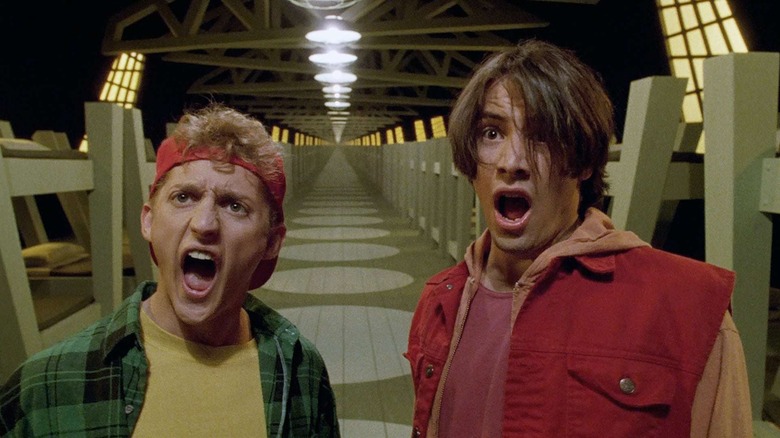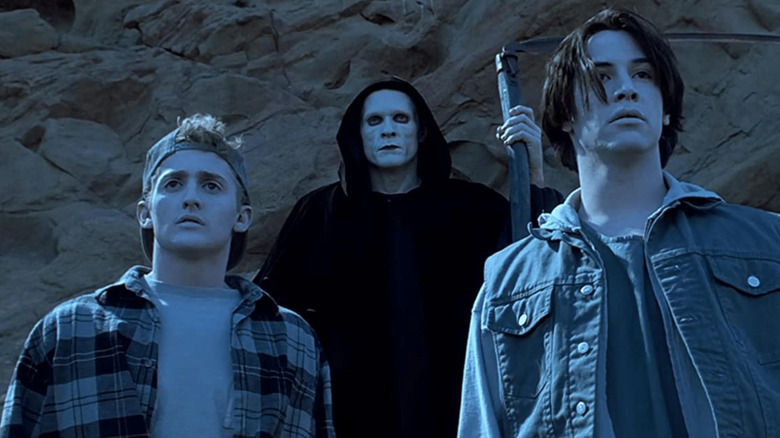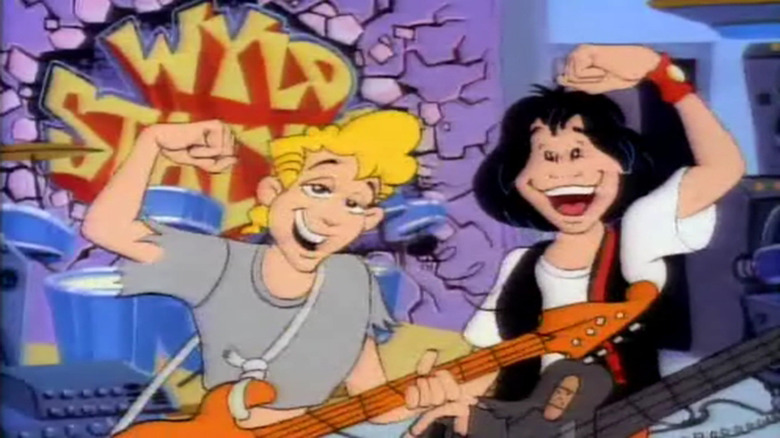The Original Idea For Bill & Ted's Bogus Journey Turned Into The TV Show
Stephen Herek's time travel comedy "Bill & Ted's Excellent Adventure" became a hit in February of 1989, attended by scads of kids charmed by the surfer-dude, innocuous-metal-loving title characters played by Alex Winter and Keanu Reeves, as well as the film's bonkers story about a high-tech flying phone booth that can take Bill and Ted to meet history's great figures. The premise (via Yahoo) was inspired by a standup improv game that screenwriters Chris Matheson and Ed Solomon created in their college days wherein the two of them would stage conversations between well-known historical figures and brainless SoCal beach rats. The film spun that concept into a story about how the SoCal beach rats were destined to serve as the saviors of humanity by creating rock music so powerfully good, it would unite humanity in the distant future. In order to continue to make music, however, the lead characters must first get an A on their high school history report, and the only way to do that is to get in a time machine brought from a protector from the future (George Carlin) and meet historical figures in person.
High concept and a little strange, "Bill & Ted's Excellent Adventure" opened with $6 million and went on to gross over $40 million domestically on a budget of $10 million.
Orion immediately demanded a sequel and, true to the cliché of studio heads being completely risk-averse, they wanted something as similar as possible to "Excellent Adventure." In an interview with ComicBook.com, screenwriters Matheson and Solomon recalled the studio notes thrown at the "Bill & Ted" sequel, the bad ideas they had to deflect, and ultimately, how the stars came in to demand that the more interesting script be made into the "Bill & Ted" sequel. 1991 saw the bonkers follow-up, Peter Hewitt's "Bill & Ted's Bogus Journey," a film about how the title characters are murdered by evil robot clones, and have to traverse the afterlife, meet Death (William Sadler), and somehow resurrect themselves. However, the other idea for the sequel still sent Bill & Ted on adventures elsewhere.
Another excellent adventure
The first studio note: Bill and Ted must, once again, meet famous historical figures and bring them into the present. Only this time, the studio wanted a bit of a spin on it, similar to the conceit of "Gumby." Says Solomon:
"There was a time there was a time when they wanted us to do a sequel to 'Excellent Adventure' that was Bill and Ted go into literature for an English test. And Chris and I railed against the idea, because it seemed like exactly the same movie done again ... And it didn't feel to us like we would be doing something fresh and original, which is why we ended up with what was originally called 'Bill & Ted Go to Hell.'"
The studio were insisting on their idea, however, and it looked like Solomon and Matheson were facing the possibility of doing someone else's idea. Luckily, Winter and Reeves stepped in:
"And we would have had to have done the Bill-and-Ted-go-into-fiction version had it not been for Alex and Keanu backing us and saying, 'We want to do the where-we-die one.'"
And that was that. In "Bill & Ted's Bogus Journey" a would-be future fascist named De Nomolos ("Ed Solomon" backwards, you see, played by veteran character actor Joss Ackland) sends robot clones of Bill and Ted back in time to kill them and take their places. After their deaths, the real Bill and Ted travel through Hell, work their way up to Heaven, and employ a dead space alien to build "good" robot clones to fight the evil robot clones. Also, there's time travel. The film climaxes at a battle of the bands. Primus makes a cameo.
The idea of sending Bill and Ted into the world of fiction, however, was not dropped completely. While "Bogus Journey" was in production, Hanna-Barbera produced a 1990 Saturday morning animated TV series inspired by the first movie, and it was called "Bill & Ted's Excellent Adventures." The series even starred Reeves and Winter in its first season.
The two Bill & Ted TV shows
"Bill & Ted's Excellent Adventures" lasted two seasons, its first handled by Hanna-Barbera and its second handed off to DIC Enterprises. Winter, Reeves, and Carlin reprised their roles from the film, but were were replaced by Evan Richards, Christopher Kennedy, and Rick Overton respectively in the second season.
While the premise started as a mirror to the feature film — Bill and Ted go back in time to meet Marco Polo in the first episode, and will later meet Sir Francis Drake, Harriet Tubman, Ivan the Terrible, Henry Ford, Queen Victoria, and Saladin — eventually they find a way to slip the surly bounds of reality and travel into fiction. In a second season episode, Bill and Ted's electrified bodies are transported into their favorite '50s sitcom, "Leave it to Badger." In another, they are merely shrunk to tiny size and have to traverse a human body. The second season plays pretty fast and loose with the time travel conceit central to the feature films.
Richards, Kennedy, and Overton would return in a 1992 live-action version of "Bill & Ted's Excellent Adventures," a half-hour sitcom that lasted a mere seven episodes. The abilities of their time traveling phone booth were stretched even further when our heroes accidentally created a living comic book character in the pilot episode. In another, Bill and Ted enter a relative's favorite soap opera and interact with the characters. Worry not, purists, as historical figures also appear: Bill and Ted meet Elvis in one episode, and accidentally force Albert Einstein into a standup comedy career in another.
The animated series is currently available to stream on The Roku Channel. The live-action series seems to have been lost to time.


